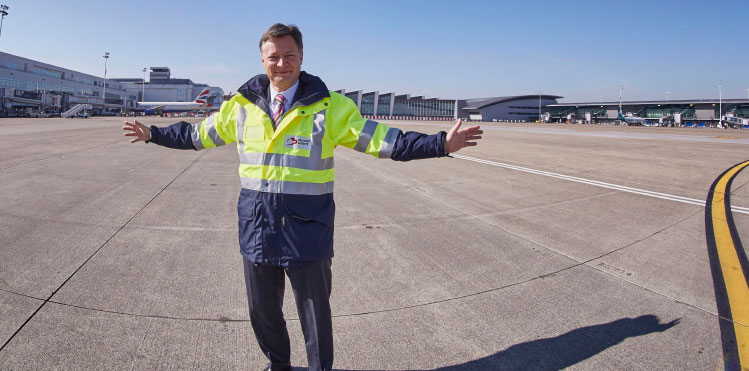
Arnaud Feist, CEO Brussels Airport Company, and ACI EUROPE President: “Our objective is to make Brussels Airport, as a Star Alliance hub, a customer-intimate airport which offers its customers an agreeable experience, easy access and differentiated services of a unique quality.”
An interview with Arnaud Feist, CEO Brussels Airport Company and ACI EUROPE President. By Ross Falconer.
Brussels Airport stands as a shining example of what can be achieved with an ambitious and forward-thinking approach. Since adopting a new strategy three years ago focused firmly on the customer experience – both passengers and partners – its achievements are myriad: Record passenger numbers, an award-winning route development strategy, impressive infrastructure developments, a considerable positive economic impact…the list goes on.
In conversation with Airport Business, Arnaud Feist, CEO Brussels Airport Company and ACI EUROPE President, articulated a progressive vision for the airport and its continued emphasis on the traveller experience. “I am a strong believer that we should look at each situation through the eyes of the passenger, as it is our duty to deliver an outstanding passenger experience throughout their entire journey,” he asserted.
It is a sentiment Feist returns to throughout our briefing on developments at Brussels Airport (BRU), describing with enthusiasm the “huge leap forward thanks to the new Connector opened between the terminal and Pier A in March 2015 and towards Pier B in the first quarter of 2016”.
Our wide-ranging discussion touched on his roles with both BRU and ACI EUROPE. Feist has been CEO and Board Member of Brussels Airport Company since 2010. He joined Brussels Airport as Chief Financial Officer in 2005 soon after its privatisation, and before that worked in several senior management positions at PwC and SCA Packaging Group. He was elected President of ACI EUROPE in June 2013.
To place the airport’s many developments in context, it is worth at this point highlighting its impressive traffic growth. Double-digit increases were reported in the first quarter of this year, building on last year’s dynamic trend that saw an annual record of nearly 22 million passengers – up 15% on 2013. “Growth was recorded in all segments. It is clear that the new approach we have been adopting in recent years is bearing fruit,” Feist commented. “The great performance in 2014 could not have been achieved without the efforts and commitment of our staff and the collaboration with our partners, which made it possible to absorb such a traffic growth. The growth of the airport also has a considerable positive impact on employment and economic growth in our country. We expect further development in 2015, with of course a stabilisation of growth.”
Major landmarks in 2014 included the 10 new routes operated by Vueling, the arrival of Ryanair, Brussels Airlines’ new routes and commercial strategy, and the arrival of Emirates. The aim is to consolidate that growth in 2015, and indeed Brussels Airlines has continued its expansion with new flights to St Petersburg, Billund, Bordeaux, Zagreb, Calvi, Dubrovnik, Lourdes, Olbia and Ibiza. Emirates, meanwhile, has built on its success by increasing capacity to a B777-300ER. “The prime target in our strategy remains to grow the Star Alliance long-haul network. Destinations such as Tokyo, Singapore, Shanghai, Houston and San Francisco are key for Brussels Airport and the Belgian economy,” Feist noted.
The rival Ryanair and Vueling operations, directly competing on several routes, have been good for BRU, stimulating traffic growth. BRU expects that competition to continue, but both airlines are already diversifying a little. Vueling closed its operation to Venice and has opened Bilbao. Ryanair has added flights to Dublin and Verona, and will open Berlin in October. “So, we expect the battle to continue, but with both carriers also expanding in another direction,” Feist added.
Last year, BRU also undertook several strategic initiatives to stimulate cargo traffic, including the IATA certification for the transport of temperature sensitive pharmaceuticals – a world first – alongside the significant investments in the BRUcargo infrastructure of the past three years. These initiatives have paid off. Qatar Cargo started at BRU in October 2014, Ethiopian Cargo in January 2015, the Chinese Yangtze River Express in March 2015, and the Canadian Kelowna Flightcraft as from May 2015. “They all give an incredible boost to our full freight cargo development, demonstrating the importance of Brussels Airport as central hub in Europe for the global air cargo industry,” Feist said.
The airport’s route development strategy has certainly borne fruit. It won several marketing awards last year – Routes Europe, World Routes, and the World Air Cargo Awards among them. “Key is the ‘have seats, will travel’ strategy,” Feist stated. “The aviation marketing team works closely with the airlines for new routes, extra frequencies and seat capacity optimisation. We share passenger data, passenger survey results, route proposals, incentive schemes and joint marketing. All based on sound market intelligence – know your customer and come forward with the right proposal.”
Connector – emblem of BRU’s new strategy
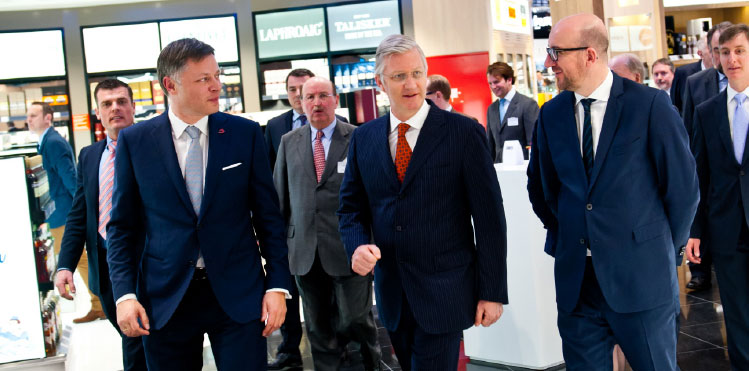
The Connector building was officially opened on 24 March in the presence of King Philip (centre) and Prime Minister Charles Michel (right), who are pictured with Arnaud Feist.
BRU, of course, is the front door to the capital of Europe. It is a unique position and one reflected in the airport’s new tagline – ‘the heart of Europe’ – introduced with last year’s rebranding. “The communication campaign around this change was strong and consistent. We noticed quite soon that the logo has been adopted and appreciated,” Feist explained.
The new visual identity is designed to reflect the core values of the airport and builds on the strategy adopted in 2012, which focuses on BRU’s customers, whether passengers or partners. “Our objective is to make Brussels Airport, as a Star Alliance hub, a customer-intimate airport which offers its customers an agreeable experience, easy access and differentiated services of a unique quality.”
Indeed, Feist speaks fluently about all aspects of the airport’s development, reserving most passion for the firm focus on the passenger experience. Concrete steps have been taken to enhance this further with the recent opening of the new Connector building – one of BRU’s most striking innovations. “Connector is the emblem of the strategy we adopted in 2012, which places the passenger at the centre of everything we do – because the first and foremost purpose of Connector is to further improve the quality of the airport infrastructure for our passengers and airlines,” Feist explained.
The €75 million project is described as the most important investment at the airport since the construction of Pier A in 2002. Connector links the terminal to the airport’s two piers, replacing the existing tunnel with a spacious new facility. Passengers will notice myriad enhancements: A quicker, more efficient security process with 25 lanes, the largest in Europe, and contemporary retail and F&B with a distinctly Belgian flavour chief among them.
Other key infrastructure developments include the renovation of the three runways over 2015-2018. Gateway, a project developed in partnership between BRU and property developers, will see the old terminal be completely renewed to welcome the 2,000 staff members of Deloitte in Belgium. “This huge project includes a full renewal of this zone and is an important step towards the ‘Airport Business District’ concept. Deloitte will move into the new offices in 2016,” Feist commented.
The Gateway project involves 36,000sqm of offices and 398 parking spaces at the very heart of BRU. It is the first office building in Belgium to be built on the actual site of an airport, following in the footsteps of similar developments at Amsterdam, Frankfurt and Munich.
Digital innovation
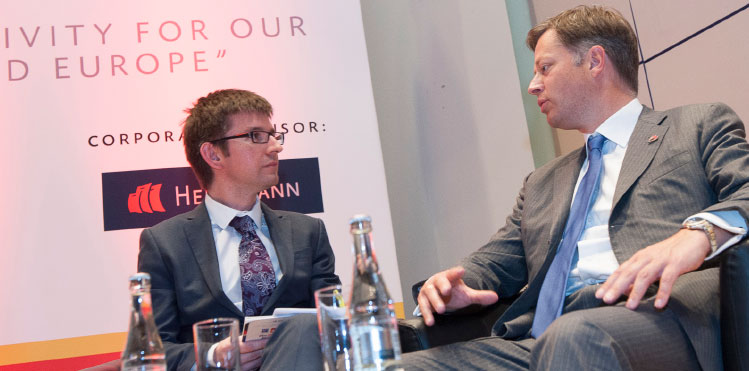
Arnaud Feist: “Our objective is to make Brussels Airport, as a Star Alliance hub, a customer-intimate airport which offers its customers an agreeable experience, easy access and differentiated services of a unique quality.”
Digital is the key enabler that allows airports to forge a direct relationship with their passengers, and BRU is embracing this in various ways. Its constant drive for innovation is seeing the installation of beacons, which are the future in communicating with passengers at every step of the airport journey, for a test project that will begin soon. The aim is to reach out to passengers in “an easy and non-invasive way”. “Passengers who have downloaded our smartphone app will receive information such as real-time road traffic information to access the airport, the latest guidelines regarding hand luggage, or a retail promotion from our shops,” Feist commented. “Passengers choose the kind of information they want to receive. We hope to improve communication with our passengers when at the airport.” While early days, it is a sign of BRU’s progressive approach, which already fully embraces social media – particularly Twitter and Facebook – to connect with passengers. Its smartphone app enables travellers to track their flight and get real-time updates (when boarding starts, which baggage belt to go to, etc).
The airport has also installed data collecting sensors in the new Connector facility, utilising WiFi to track passengers via their personal electronic devices. The aim is to reduce queues and common bottlenecks. “We use this data to track and monitor queues. This is useful to plan and evaluate staffing, and to detect problems. All this is done whilst respecting the privacy of the passengers,” Feist explained. “We also use these waiting times on the screens in shopping areas before security screening and on our app – to give passengers an indication of how long it will take to get through security and to their plane.”
BRU a centre of economic growth
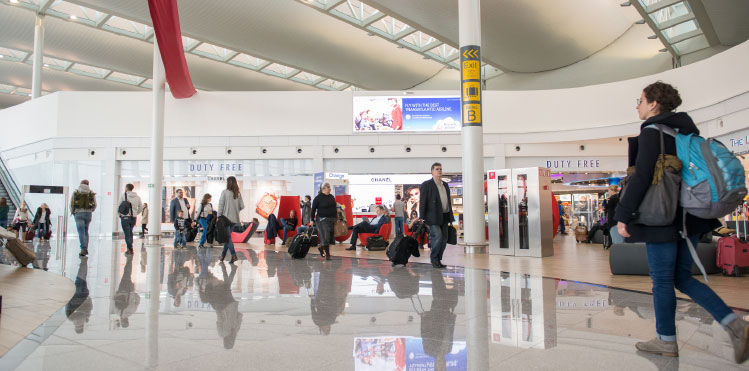
Non-aeronautical revenues are, of course, crucial and currently account for 33% of the total at BRU. The new Connector building is home to a state-of-the-art retail and F&B complex.
The link between air connectivity and economic activity is clear, and Feist asserted that “the growth of the airport has a considerable positive impact on employment and economic growth in our country”. The figures certainly bear this out. Brussels Airport is the second most important centre of economic growth in Belgium, with an added value to the Belgian economy of €3.2 billion each year. “About 260 companies are active on our airport, and offer a wide range of jobs in logistics, restaurants and bars, shops, maintenance, administration, security, cleaning, etc,” Feist explained. “The airport provides direct and indirect employment for 60,000 people, so 20,000 direct and 40,000 indirect jobs. In this regard, we can’t underestimate the importance of Brucargo. 100,000 of tonnes freight is equal to 1,000 direct jobs and 2,000 indirect jobs. With a tonnage of 454,000 last year, nearly a quarter of our jobs are found at Brucargo.”
ACI EUROPE has released a new study on the Economic Impact of European Airports (a full article on this can be found on p16). Conducted by InterVISTAS, the study independently quantifies and documents the economic contribution of the airport industry, revealing that Europe’s airports contribute to the employment of 12.3 million people earning €365 billion in income annually. Overall, they generate €675 billion of GDP each year, accounting for 4.1% of GDP in Europe.
“With the European Commission now conducting a review of aviation policy and preparing a new Aviation Package, there is a need to better explain and substantiate the crucial role of air connectivity – and its interactions with the economy. That is what this study is about,” Feist stated. “The figures on airports’ contribution to jobs and GDP are impressive. They clearly show that airports and their associated aviation partners are not just providing a service to other industries and the travelling public, but that they are in fact a key driver and facilitator of economic growth and prosperity in today’s globalised world. While economic growth naturally supports air connectivity, increased air connectivity also supports wider economic growth.”
Focus on sustainability
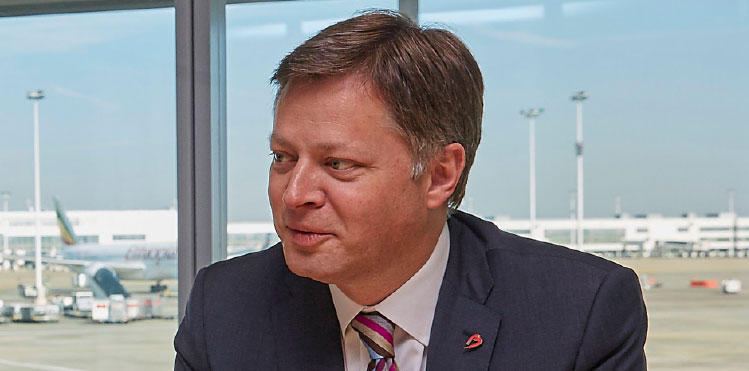
Commenting on ACI EUROPE’s new study on the Economic Impact of European Airports, Feist said: “With the European Commission now conducting a review of aviation policy and preparing a new Aviation Package, there is a need to better explain and substantiate the crucial role of air connectivity – and its interactions with the economy. That is what this study is about.”
Sustainability is clearly central to the development of BRU – measures include a water treatment plant, solar panels, and even beehives, while the new runway lighting systems will use energy-efficient LED technology. The airport is also accredited at the Optimisation level of Airport Carbon Accreditation. “For Brussels Airport Company this includes implementing action plans to reduce the consumption of natural gas, electricity and fossil fuels,” Feist explained. “Various airport partners also collaborated regarding Continuous Descent Operations (CDO) or ‘green landings’, and Collaborative Decision Making (CDM). Brussels Airport was the second airport in Europe to be CDM-certified in 2012. Also, the waste, energy and water management policy was set up in joint collaboration. Every new project at Brussels Airport is evaluated in order to manage emissions and make sure we stay at this Optimisation level.”
There has also been widely-reported controversy regarding aviation noise over Brussels, following flight path changes made under the Plan Wathelet. Commenting on this, Feist said: “The flight paths are the competence of the Minister of Mobility. The new Minister issued new flight paths in early April. Brussels Airport is working on its Masterplan 2040; the expected traffic growth requires an increase to daytime capacity, whilst maintaining night capacity at its current level.”
State-of-the-art commercial environment
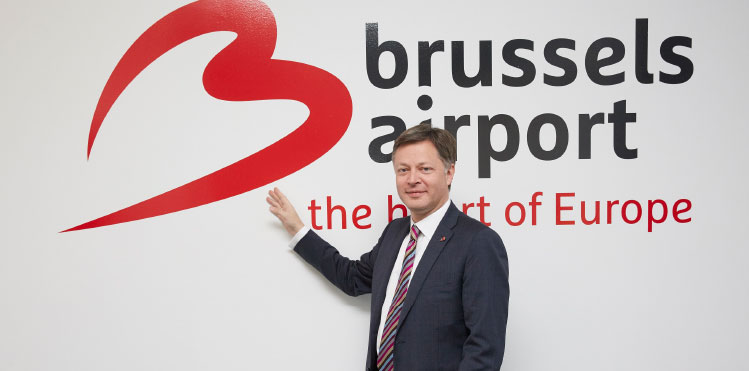
Arnaud Feist: “The airport provides direct and indirect employment for 60,000 people, so 20,000 direct and 40,000 indirect jobs.ˮ
Non-aeronautical revenues are, of course, crucial and currently account for 33% of the total at BRU. Feist articulated a desire to increase the share of commercial revenues in the total revenues. Plans for a step-change in the commercial environment are perhaps most vividly seen in the new Connector building, part of which is home to a state-of-the-art retail and F&B complex.
Passengers will enter the Connector through a brand new walkthrough duty free store housing liquor, tobacco and beauty products. Many high-end fashion brands will be present, including Zegna, Ralph Lauren, Ferragamo, Delvaux and Hugo Boss. The complementary F&B offer will feature an upmarket seafood restaurant – Black Pearls, and a new patisserie concept – Blend in Brussels. “One of the key aspects of this project is that passengers will be able to do all of their shopping on one level, and every single passenger will walk past every shop. Also the local touch will be represented, allowing passengers to sense and taste the true culture of Belgium, best illustrated by the 6m high Tintin rocket,” Feist enthused.
It is clear that BRU’s progressive approach touches every aspect of its operations. Considering all developments “through the eyes of the passenger” has produced tangible results in the airport’s desire to deliver an outstanding passenger experience, befitting of the airport at ‘the heart of Europe’.
BRU factbox
2014 passenger numbers: 21.9 million
2014 passenger traffic growth: +14.6%
2015 passenger traffic growth (Jan-march): +13.3%
Top destination: Spain (15% of passengers)
Largest carriers: Brussels Airlines, Jetairfly, Thomas Cook Airlines, easyJet, Ryanair







